Hi, I'm Paul Robinson, a cook, photographer and hill walker based in Wakefield, West Yorkshire.
Don't wanna be here? Send us removal request.
Photo
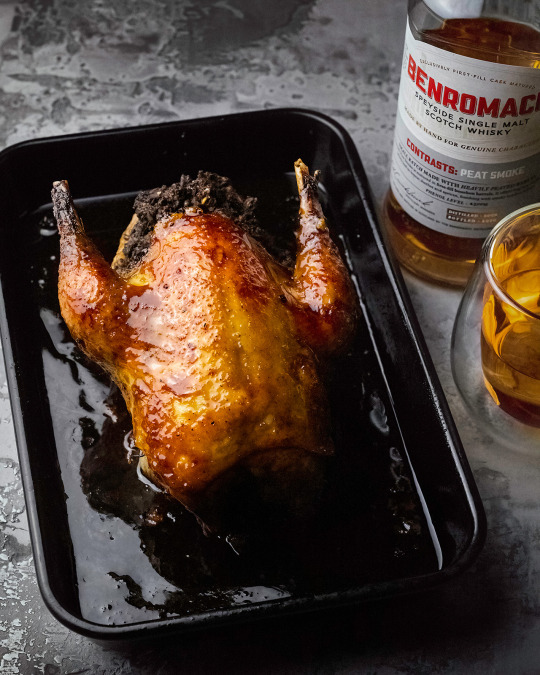
Honey and Whisky Glazed Roast Pheasant
Pine honey and Benromach Peat Smoke Scotch Whisky glazed roast pheasant with a haggis and chestnut stuffing. Served with gold salted duck fat fried waffle cut potato crisps, pickled red onion, watercress, vinaigrette. I cooked two pheasants and greedily devoured one of them, unapologetically stripping the meat off the carcass with my hands mopping up the whisky glaze from the roasting pan as if I hadn't eaten for months. The smokiness in the whisky is a perfect match with the pheasant coupled with the richness of the honey. Accentuated with a glass of whisky alongside. Benromach Peat Smoke is produced in small batches and matured in first-fill bourbon barrels offering fragrant vanilla notes which lead to lemon sherbet and apricot, finishing with smoky bonfire embers due to the heavily peated barley... A beautiful winter tipple during these cold, dark months. 'Please enjoy Benromach responsibly'!
The whisky and honey glaze is ultra-simple to make and would easily go well brushed onto a steak, a burger or other roast meats. Here's the recipe:
120ml Benromach Peat Smoke Scotch Whisky
140ml pine honey
2tbsp soft dark brown sugar
1tsp garlic granules
1tsp onion granules
1/4 tsp cayenne pepper
a splash of Henderson's Relish (or Worcestershire Sauce)
Simply put all the ingredients into a pan, bring to the boil then reduce to a simmer until the glaze thickens to a syrupy consistency.
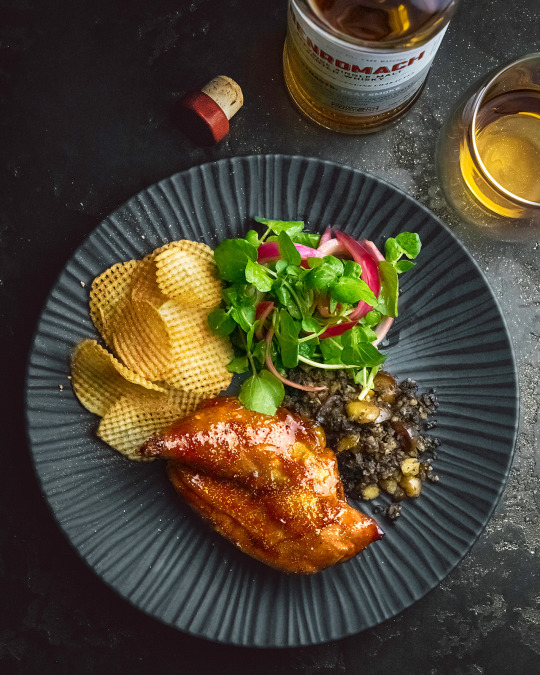
To roast the pheasant:
1 pheasant
a generous handful of cooked haggis
a generous handful of roasted chestnuts, crushed
8 juniper berries, crushed to a powder
sea salt and black pepper
rapeseed oil
Pre-heat your oven to 180°C. Mix the haggis and chestnuts and stuff into the cavity of the pheasant. Place on a roasting tray and smother the bird with a little rapeseed oil. Season with crushed juniper berries, sea salt and black pepper. Roast for 30-45 minutes depending on the size of the bird. Once cooked, the internal temperature of the breast meat should read 63°C with a digital temperature probe, the leg meat 80 to 82°C. Brush the bird at intervals with whisky and honey glaze. Let the bird rest for about 10 minutes before carving.
For the waffle cut crisps:
2 medium-sized Maris Piper potatoes, peeled
300g duck fat (or 300ml rapeseed oil)
Gold salt (optional) or sea salt
Use a mandolin with waffle cut setting to slice the potatoes. Heat the duck fat (or rapeseed oil) in a pan to 170°C. Fry the potato slices for about 30 seconds until golden. Drain on kitchen paper and sprinkle with sea salt.
For the pickled red onion:
1 medium red onion, sliced into wedges
100ml red wine vinegar
½ tsp sea salt
½ tsp sugar
¼ tsp chilli flakes
Put the red wine vinegar, salt, sugar and chilli flakes into a small pan and bring to the boil, reduce to a simmer until the sugar has dissolved. In a small bowl, pour the contents of the pan over the red onion and leave to cool for at least an hour or refrigerate overnight.
For the vinaigrette:
50ml white wine vinegar
1 tbsp cold water
1 tbsp whole grain mustard
¼ tsp sugar
Sea salt and black pepper
200ml rapeseed oil
Put all of the ingredients apart from the rapeseed oil into a jug, then slowly pour in the rapeseed oil while blitzing with a hand blender until the vinaigrette has emulsified. Store in the fridge until needed. Will keep for a couple of weeks.
3 notes
·
View notes
Photo
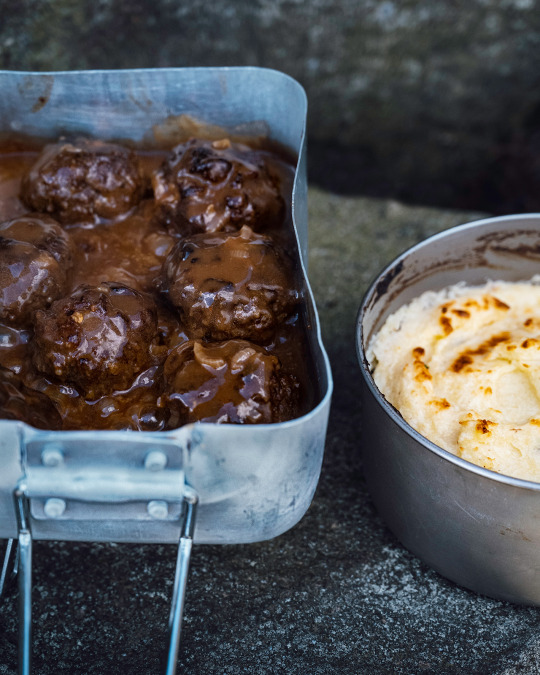
Black ‘n Blue Meatballs
Belted Galloway British Beef Meatballs with Black Garlic and Blackstick’s Blue in a Beef ‘n Onion Gravy with Black Sheep Ale and Applewood-Smoked Mash with Bone Marrow and Colman's English Mustard. Heights of comfort food.
The minced beef used in this recipe comes from Bilsdale Belties’ own herd of Belted Galloway, a hardy native breed that rough graze at Bilsdale in the North York Moors. The quality of the meat is excellent, with a superb depth of flavour and that recognisable grass fed taste. Arguably some of the best beef I’ve tasted!
Meatballs
900g Bilsdale Belties Belted Galloway Steak Mince
1 large onion, finely chopped (220g prepared weight)
10 cloves of black garlic (20g)
2 sprigs of rosemary, leaves picked and finely chopped
a small bunch of thyme, leaves picked and finely chopped
2 tbsp Yorkshire rapeseed oil
2 tbsp Henderson’s Relish
2 tbsp cold water
100g dried breadcrumbs
80g Blackstick’s Blue cheese, diced into 20 cubes
Maldon smoked sea salt
freshly ground black pepper
Heat the rapeseed oil in a frying pan over a moderate heat then add the chopped onion, black garlic and herbs. Cook gently until the onion is completely soft, about 10 to 15 minutes. Add the Henderson’s Relish and cold water, stir then simmer until the liquid has reduced, a few minutes. Place the contents of the pan into a large bowl, season to taste with smoked sea salt and freshly ground black pepper, then let the mixture cool completely.
When the mixture has cooled stir in the breadcrumbs then add the steak mince. Use your hands to scrunch the mixture together until well combined.
Use your hands to form 20 meatballs, place a piece of cheese in the centre of each meatball.
Place the meatballs on a tray and place in the fridge for at least half an hour before cooking. Meanwhile, make the gravy and mash.
To cook the meatballs, preheat the oven to 200°C / 180°C (fan-assisted). Place a sheet of greaseproof paper on a large baking tray then place the meatballs on top evenly spaced apart. Cook the meatballs for 20 minutes until nicely browned.
Beef ‘n Onion Gravy with Black Sheep Ale
1 large onion, finely sliced
40g butter
40g plain flour
200ml Black Sheep Ale
500ml beef stock (made from 1 Kallo organic beef stock cube)
250ml boiling water
2 tsp Bovril
1 tbsp bilberry jam (or seedless blackberry jam)
2 tbsp malt vinegar
Maldon smoked sea salt
ground white pepper
Melt the butter in a saucepan over a medium heat then add the sliced onion. Cook gently until the onion is golden. Whisk in 40g plain flour and stir for two minutes until the flour smells nutty. Gradually add the beer and beef stock while whisking. Followed by 250ml boiling water. Whisk in the Bovril, bilberry jam and malt vinegar. Simmer gently for 30 minutes whisking from time to time. Season to taste with Maldon smoked sea salt and white pepper.
Applewood-Smoked Mashed Potatoes with Bone Marrow and Colman’s Mustard
500g Maris Piper potatoes, peeled and quartered
50g unsalted butter
50ml whole milk
170g bone marrow
2 tsp Colman’s English Mustard
Freshly grated nutmeg
Maldon sea salt
ground white pepper
Equipment required:
Cameron stovetop smoker + applewood smoking chips
Potato ricer
To smoke the potatoes, you need a Cameron stovetop smoker: Add a layer of applewood smoking chips in the base of the smoking tray then place the potatoes on top of the grill mesh. Place the lid on the smoker and smoke the potatoes for about 10 to 15 minutes until they’ve turned golden brown.
Place the smoked potatoes in a pan and cover with cold water, add some sea salt then bring to the boil and reduce to a steady simmer. Cook the potatoes for about 15 minutes then drain in a colander. Meanwhile, roast the bone marrow: Preheat the oven to 180°C. Place the bone on a roasting tray and roast for 15 minutes. Remove from the oven and scoop out the marrow then finely chop or mash it with a fork. Discard the bone (give it to your dog if you have one). Set aside until the potatoes are cooked. I use a ricer to ‘mince’ the cooked potatoes which results in smooth and fluffy mash, no lumps. In the same pan that you cooked the potatoes in, add the butter and milk. Add a good grating of nutmeg, about a teaspoon of Maldon sea salt and a good pinch of white pepper. Heat over a moderate heat until all the butter has melted then stir in the riced potatoes. Add the cooked chopped bone marrow and Colman’s mustard and stir again until everything is well incorporated. Season the mash to taste with sea salt and white pepper.
#meatballs#heritagemeat#bilsdalebelties#beltedgalloway#outdoorcooking#hiking#yorkshire#yorkshiregourmet
2 notes
·
View notes
Photo

Whisky Glazed Côte de Boeuf with a Dark Chocolate and Whisky Ganache
Benromach Organic is the world’s first fully certified organic single malt Scotch whisky. It’s a Speyside whisky, smooth and mellow bodied with sweet, malty and subtle pepper notes alongside dried banana, freshly ground coffee and dark chocolate, creamy on the palate like butterscotch – bloody lovely! Chocolate and whisky are a perfect combo. After some taste testing (it’s a hard life eh?), I found that Benromach Organic pairs well with a good single origin dark milk chocolate of around 50 to 55% cocoa solids, 60% maximum. I paired the whisky with 55% single origin Peruvian dark milk chocolate to make a creamy, savoury and buttery ganache flavoured with dried porcini, sea salt and black pepper and a touch of chilli powder and nutmeg, garnished with edible 23ct gold leaf and gold salt to serve with a 23oz oak-smoked spice-rubbed grass-fed 30-day dry aged Hereford Côte de boeuf with a whisky glaze, shoestring fries with rosemary, and a salad of frisée, radicchio, parsley and red onion in a balsamic and wholegrain mustard dressing to cut through the flavours. Served quite sparingly, so as not to overpower the flavour of the beef, the intense, dark, savoury ganache melts on top of the steak enhancing and complementing the flavour. Along with the steak rub and whisky glaze this is one steak with bags of flavour! As always, buy the best beef you can, preferably dry-aged grass-fed, ethically and sustainably sourced – I opted for Hereford, but Dexter, Longhorn and Highland would also make an excellent choice for depth of flavour.
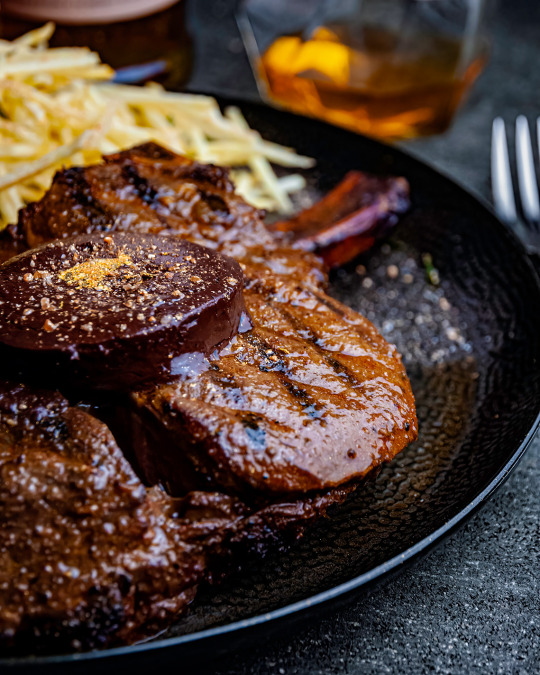
Dark Chocolate and Benromach Organic Scotch Whisky Ganache:
50g good quality single origin 55% dark milk chocolate
50ml whipping cream
50g unsalted butter, diced
1 tbsp Benromach Organic whisky
10g dried porcini, blitzed to a powder
a pinch of mild chilli powder
a pinch of freshly grated nutmeg
1 tsp of Maldon sea salt
freshly ground black pepper
To serve:
a pinch of edible gold leaf flakes, to garnish (optional)
gold salt (optional)
1. Chop up the chocolate and place it in a small heat-proof bowl then add the porcini and chilli powder, nutmeg, sea salt and black pepper.
2. Pour the whipping cream in a small pan and heat until it just reaches boiling point.
3. Pour the cream over the chocolate then stir the chocolate and cream together in one direction and while you’re stirring pour in the whisky a few drops at a time.
4. Keep stirring until the mixture is completely smooth and the chocolate has completely melted.
5. Add the butter until stir again until it’s completely melted and combined.
6. Place the bowl in the fridge for a few minutes so that the ganache starts to thicken.
7. Remove from the fridge and stir again.
8. Once the ganache has begun to set, use a spatula to pour the ganache onto baking parchment then roll the ganache into a log shape. Wrap in clingfilm and place in the fridge to set until ready to use.
Steak Rub:
For four 450g steaks:
1 tbsp smoked paprika
1 tsp soft dark brown sugar
1 tsp freshly ground black pepper
1 tsp dried oregano
½ tsp Maldon sea salt
½ tsp dried onion granules
½ tsp ground cumin
a pinch of cayenne pepper
Whisky glaze:
For four 450g steaks:
100ml Benromach Organic whisky
2 tsp soft dark brown sugar
20ml extra virgin Yorkshire rapeseed oil
Place all the ingredients in a small pan and bring to the boil, whisking until the sugar has dissolved. Reduce the heat and simmer until the liquid has reduced to a thick syrupy consistency, whisking from time to time.
Salad:
A few handfuls of winter salad leaves
a small bunch flat leaf parsley, leaves picked
1 small red onion, finely sliced
For the wholegrain mustard and balsamic dressing:
30ml good quality balsamic vinegar
30ml good quality extra virgin olive oil
1 tsp wholegrain mustard
a squeeze of lemon juice
a pinch of Maldon sea salt
a pinch of freshly ground black pepper
Simply place all the ingredients in a clean jar, put the lid on and shake vigorously for 30 seconds until the dressing has emulsified.
Shoestring Fries:
Maris Piper potatoes
sunflower oil, for deep frying
a sprig of fresh rosemary, leaves picked
Peel the potatoes then use a mandolin with a julienne slicer, to cut the potatoes into thin strips then place in a bowl of ice-cold water to remove the starch. Rinse thoroughly under cold running water in a colander, then pat dry on kitchen paper as thoroughly as possible.
Heat a deep-fat fryer to a medium/high heat (approx. 170°C) then fry for about 3 to 5 minutes until the shoestring fries are crisp and lightly golden. Add the rosemary leaves to the fryer in the last minute of cooking time. Place the shoestring fries on kitchen paper to absorb excess oil.
Steak:
Remove the steak from the packaging and allow to breath for 10 minutes then drizzle with extra virgin Yorkshire rapeseed oil then sprinkle with about a tablespoon of the steak rub. Let the steak come to room temperature before you cook it. I used a Cameron stovetop smoker and smoked the steak over oak wood chips over a moderate heat. Depending on the size of steak you choose, here are some cooking guidelines:
Côte de boeuf (660g):
Pre-heat oven to 220°C / 200°C fan / gas mark 7.
Lightly smoke the steak for 10 minutes (optional).
Seal the steak in a griddle or frying pan on both sides.
Transfer the steak to an oven tray then place in the preheated oven.
Rare: 10-15 mins. Medium: 15-20 mins. Well done: 25 mins.
Brush with the whisky glaze.
Rump steak (450g, thick cut):
Lightly smoke the steak for 5 minutes (optional).
Heat a griddle pan or frying pan to a high heat.
Rare: 12 mins, turning halfway. Medium: 14 mins, turning halfway. Well done: 17 mins, turning halfway.
Brush with the whisky glaze.
After cooking: Let the meat rest for 5 to 10 minutes before serving. Place about a tablespoon of the ganache, cut into a disc, on top of the steak. Garnish with edible gold leaf and gold salt. Serve with the shoestring fries and salad.
4 notes
·
View notes
Photo
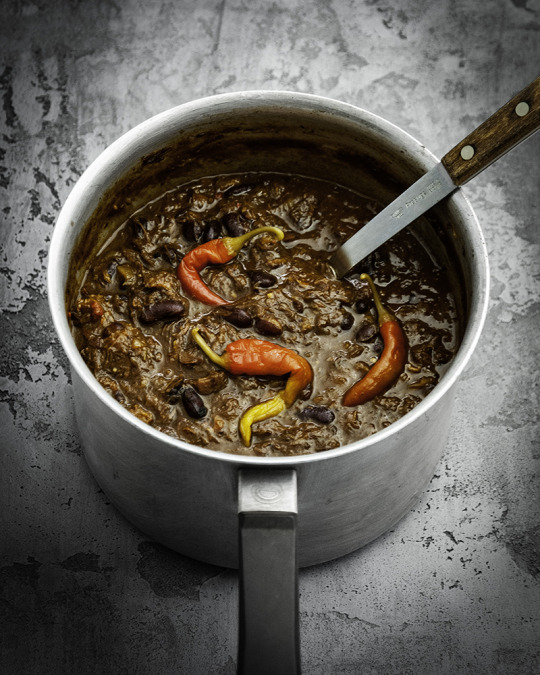
Cowboy Chilli
I did a bit of research into the origins of chilli in an attempt to try and get a flavour of the American southwest, stripped back to what would have originally been cooked over a campfire. Currently not being able to head to the woods and light a fire due to the lockdown, I opted to brown and smoke the meat (beef rib trim from Donald Russell) over mesquite and lump wood charcoal in the Kamado Joe Jr. before slow-braising for three hours in strongly brewed coffee and beef stock until the meat falls apart. I utilised the embers and put a few onions in there to cook for an hour or so which imparts a slight smokiness while retaining all the sweetness of the onion. For authenticity, no tomatoes went into this chilli. It really didn't require it. The heat comes from ancho and chipotle chillies with pickled chillies to serve (for extra heat). A little sweetness from muscovado sugar, plenty of garlic and oregano. The result - rich and slightly smoky, beef with loads of flavour (unlike minced beef which essentially just becomes texture) and plenty of heat - better than any chilli I've tasted in a long time.
Serves 4.
Ingredients:
2 x 440g packs Donald Russell Beef Rib Trim
2 x 400g tins red kidney beans, drained
3 medium brown onions
4 garlic cloves, peeled and minced
1 lager fresh red chilli, de-seeded and finely chopped
500ml strongly brewed coffee
400ml beef stock
1 dried ancho chilli, rehydrated and finely chopped
1 tbsp dried chipotle chilli flakes
2 tsp ground cumin
2 tsp smoked paprika
½ tsp cayenne pepper
2 tsp dried oregano
1 tbsp dark muscovado sugar
chipotle sauce, to taste
sea salt
black pepper
sunflower oil, for frying
mesquite wood, for smoking the meat
pickled chillies, to serve
baked potatoes or boiled rice, to serve
Method:
1. Place the defrosted beef trim on the grill and smoke the meat over mesquite wood at 150°C (indirect heat) for 30 minutes. Turn the meat over halfway through.
2. Heat a large pan over a moderate heat then add the beef trim and sprinkle with the ground cumin, smoked paprika, cayenne pepper and some freshly ground black pepper then stir to coat with the spices. Pour in the beef stock and coffee and simmer very gently for three to four hours. Let the pan cool (preferably overnight) then remove as much of the excess fat in the pan as possible.
3. Meanwhile, let the coals die down then place the onions in the embers. Put the lid on the Kamado Joe and bake the onions in their skins for up to an hour until soft. Check from time to time, turning the onions over at least once. Remove the onions from the embers, dust off any charcoal, peel away the papery skins then roughly chop the onions and set aside until needed.
4. Return the pan of beef to the heat and bring to a steady simmer. Use a wooden spoon to gently break up the meat which should already be falling apart.
5. In a separate frying pan, add a tablespoon of sunflower oil and gently fry the chopped fresh chilli, garlic and ancho chilli for a minute or so. Transfer the chilli and garlic to the meat then stir to incorporate.
6. Add the chopped ember-baked onion, dried chipotle chilli flakes, sugar and dried oregano and stir again.
7. If the pan looks a little dry, add more strongly brewed coffee. Simmer gently for about half an hour until the sauce has thickened. About ten minutes before the end of the cooking time, add the red kidney beans.
8. Taste the chilli, add a splash of chipotle sauce if you want more heat, a sprinkle of sea salt to taste and a little extra sugar if it requires more sweetness.
9. Served with pickled chillies, baked potatoes or boiled rice.
5 notes
·
View notes
Photo

Wild Garlic Butter Chicken Kiev
These chicken Kievs are so tasty! Crunchy on the outside, soft and tender chicken breast filled with a sublime wild garlic butter that melts and oozes when you slice into the Kiev. They’re actually really simple to make too. It’s important to chill the Kievs in the fridge so that the breadcrumbs stick to the crust when you come to cook them.
Serves 4.
Ingredients:
4 free-range or organic skinless chicken breasts
150g fine panko breadcrumbs
70g plain flour
2 eggs, whisked
2 tsp smoked paprika
fine sea salt
ground white pepper
sunflower oil, for frying
For the wild garlic butter:
125g unsalted butter
a large handful of wild garlic leaves, finely chopped
2 tbsp flat leaf parsley, finely chopped
2 tbsp thyme leaves, finely chopped
a pinch of sea salt
Method:
1. To make the wild garlic butter: Put the butter in a bowl and soften at room temperature. When the butter is soft enough, add the rest of the ingredients and mix until well combined.
2. To prepare the chicken: Cut away the inner breast fillet and set aside. Using a filleting knife, cut a slit through the middle of the breast starting at the thickest end. Be careful not to cut through the chicken all the way through otherwise the butter will leak during cooking.
3. Push as much butter as you can inside the middle of the chicken breast being careful not to overfill otherwise this may cause the meat to split.
4. Cut away a section of the inner fillet and use this to plug the hole in the chicken in the breast, this will prevent the butter from leaking.
5. Place the flour on a large plate and mix with a pinch of ground white pepper, sea salt and the smoked paprika.
6. Place the panko breadcrumbs on a separate plate and the whisked eggs on another.
7. Evenly coat each chicken breast with flour then egg then breadcrumbs.
8. Place the Kievs in the fridge for at least 20 minutes or until ready to use.
9. When you’re ready to cook, remove the Kievs from the fridge and pre-heat the oven to 180°C / 350°F / Gas Mark 4.
10. Warm a layer of sunflower oil in a large non-stick frying pan over a moderate heat.
11. Place the Kievs in the pan and gently cook for about 3-4 minutes on either side until the breadcrumbs are golden. If you do this in batches, you may need to replace the oil as some of the breadcrumbs will burn and blacken in the oil.
12. Put the Kievs on a baking tray and bake in the preheated oven for 15-20 minutes until cooked through.
2 notes
·
View notes
Photo
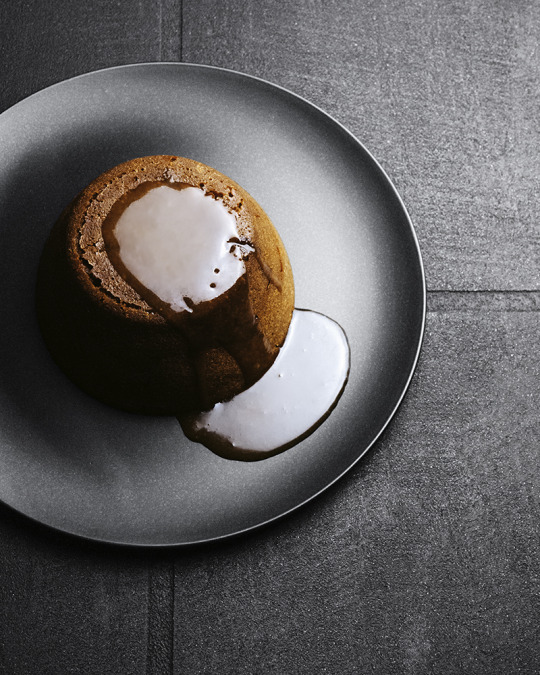
Gingerbread Pudding with Butterscotch Sauce
A recipe from an old cookbook I found in a charity shop called The Way To A Good Table – Electric Cookery by Elizabeth Craig published back in 1937 by The British Electrical Development Association Inc. The pudding was dead simple to make, the only tweak on my part being an extra teaspoon of ground ginger. The pudding takes several hours to steam but at a time of lockdown during the current coronavirus pandemic, time isn’t really an issue at the moment. When the pudding had cooked, I knew it was going to be good! The warm, heady gingerbread aromas, deeply inhaled, were lush. Served simply with a butterscotch sauce. A drizzle of cream or scoop of vanilla ice cream would go nicely!
Serves 4.
Ingredients:
57g self-raising flour
85g dark brown sugar
168g treacle or golden syrup
142ml milk
170g fresh breadcrumbs
1 egg
85g shredded vegetable suet
28g crystalised ginger in syrup, chopped
2 tsp ground ginger
a pinch of salt
butter, for greasing
1. Put the breadcrumbs, suet, flour, sugar, ground ginger and salt in a large mixing bowl. Stir until well blended. Put the milk and treacle in a saucepan and heat gently until the treacle has melted but don’t boil. Pour into the mixing bowl and mix with the dry ingredients. Beat the egg then mix that into the dry ingredients.
2. Grease a pudding basin with butter then pour in pudding mixture. Cover with a layer of baking parchment then a layer of tin foil and tie with string.
3. Steam for 3 hours.
4. To check the pudding is cooked, insert a skewer, it should come out clean. If it isn’t continue steaming the pudding. Alternatively, place the pudding in the oven pre-heated to 150°C (fan-assisted) and cook for a further 10 to 15 minutes and test with a skewer again before serving.
5. To serve, turn the pudding out onto a plate and serve with butterscotch sauce.
For the butterscotch sauce:
50g butter
110g golden syrup
110g soft dark brown sugar
150ml double cream
a few drops of vanilla extract
Put everything except the vanilla extract and cream into a heavy saucepan. Heat moderately stirring until the sugar has dissolved. Let the pan simmer for 5 minutes. Pour in the cream and add the vanilla extract, stir until the cream is well blended in and allow the pan to froth a little. Remove the pan from the heat and serve.
2 notes
·
View notes
Photo
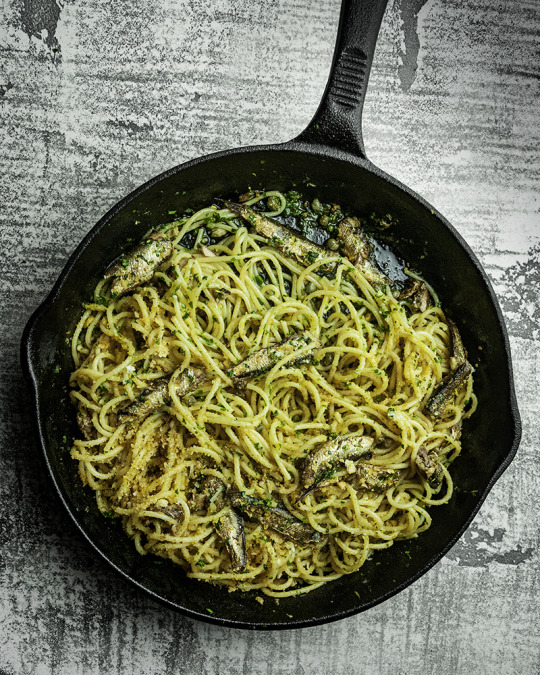
Spaghetti with Smoked Brisling Sardines, Wild Garlic, Capers, Parmesan and Breadcrumbs
A store cupboard raid. My take on the classic Sicilian pasta dish, so easy to knock up and so good! Chances are you might have most of the ingredients in your pantry but if you can’t obtain any wild garlic, then substitute it with two garlic cloves and a small bunch of flat leaf parsley, finely chopped. Add the garlic when you cook the sardines then add the parsley in place of the wild garlic. Delish!
Serves 2.
Ingredients:
180g dried spaghetti
120g tin of sardines in olive oil (I used Riga Gold Smoked Brisling Sardines)
a handful of wild garlic leaves, finely chopped
2 tbsp baby capers, drained
zest of 1 lemon plus juice to taste
1 tsp dried chilli flakes
extra virgin olive oil
25g Parmigiano Reggiano, finely grated
good quality extra virgin olive oil
freshly ground black pepper
For the breadcrumbs:
2 slices of stale bread (approx. 45g)
1 sprig of rosemary, leaves picked and roughly chopped
1 tsp dried chilli flakes
3 tbsp extra virgin olive oil
sea salt
freshly ground black pepper
Method:
Make the breadcrumbs first:
1. Preheat the oven to 220°C / 200°C fan / Gas Mark 7.
2. Tear the bread into 1-inch sized pieces then place in a roasting tray.
3. Scatter the rosemary and dried chilli flakes over the bread then drizzle with extra virgin olive oil.
4. Season with sea salt and black pepper.
5. Put the roasting tray in the oven, when the bread has turned golden remove from the oven. This should take around 5 to 8 minutes.
6. When the bread has cooled, blitz in a food processor then set aside.
Then proceed with the pasta:
1. Cook the spaghetti in boiling salted water according to the packet instructions then drain.
2. Heat a large frying pan over a moderate heat then add the tin of sardines including the oil, cook for a couple of minutes breaking the sardines up slightly.
3. Add the dried chilli, capers and lemon zest and a squeeze of lemon.
4. Add the spaghetti to the pan along with the wild garlic then stir everything together until well combined.
5. Drizzle with a tablespoon or so of extra virgin olive oil, season with freshly ground black pepper then scatter over some parmesan and breadcrumbs to your liking.
4 notes
·
View notes
Photo

Beef Keema
I love a good keema, really moreish and comforting. I usually make it with minced lamb but here I opted for beef for a change, just as good. I like things quite punchy in the heat department, so plenty of cumin, garam masala, fresh red chillies, ginger and enough chilli oil to sort out a bad cold. Proper satisfying. Serve with naan bread or as I did here with steamed brown basmati rice and Bombay potatoes.
Serves 4.
Ingredients:
500g lean minced beef
400g tin chopped tomatoes
250ml water
1 fresh red chilli, finely chopped (keep the seeds)
1 onion, finely chopped
2 garlic cloves, peeled and minced
1 x 5cm piece root ginger, peeled and finely grated
1 tbsp ground cumin
1 tbsp garam masala
1 tbsp hot chilli powder
1 tsp ground turmeric
200g frozen peas
a pinch of sugar
chilli oil, to serve
a small bunch of fresh coriander, leaves picked
1 lime, cut into quarters
vegetable oil, for frying
Method:
To make the keema:
1. Heat about a tablespoon of vegetable oil in a large saucepan over a medium heat.
2. Add the finely chopped onion and crushed garlic and fry for about 6 to 8 minutes then add the chilli and ginger along with the dried spices; cumin, garam masala, chilli powder and turmeric. Stir everything around in the pan and enjoy the aromas as the spices release their aromatics!
3. Add the minced beef breaking it up as finely as you can with a fork as you fry it, about 5 to 6 minutes.
4. Pour in the tin of chopped tomatoes. Pour 250ml water into the tin, swirl the water around then pour into the pan. Add a pinch of sugar then stir everything around. Simmer for about 20 minutes.
5. Pour a little chilli oil into the pan for extra oomph and according to taste and your heat threshold.
6. Add the peas and cook for about 6 minutes or so until they’re soft.
7. Add a squeeze of lime to the keema, again to taste, to lift the flavours.
8. Scatter some fresh coriander leaves over the keema just before serving.
To make the Bombay potatoes:
400g potatoes, peeled and cut in cubes
½ tsp yellow mustard seeds
½ tsp black onion seeds
½ tsp ground turmeric
a good pinch of chilli powder
rapeseed oil (or ghee), for frying
sea salt, to taste
1. Add the potatoes to a pan of salted boiling water, then drain in a colander and allow to cool.
2. Put two tablespoons of rapeseed oil (or ghee) in a pan over a medium heat.
3. Add the yellow mustard seeds and black onion seeds. Wait for the seeds to pop in the hot oil then add a good pinch of chilli powder and the turmeric and stir into the hot oil.
4. Add the cooked diced potatoes, stir to coat in the spices. Fry for about six minutes or so until crisp. Season with sea salt to taste.
3 notes
·
View notes
Photo
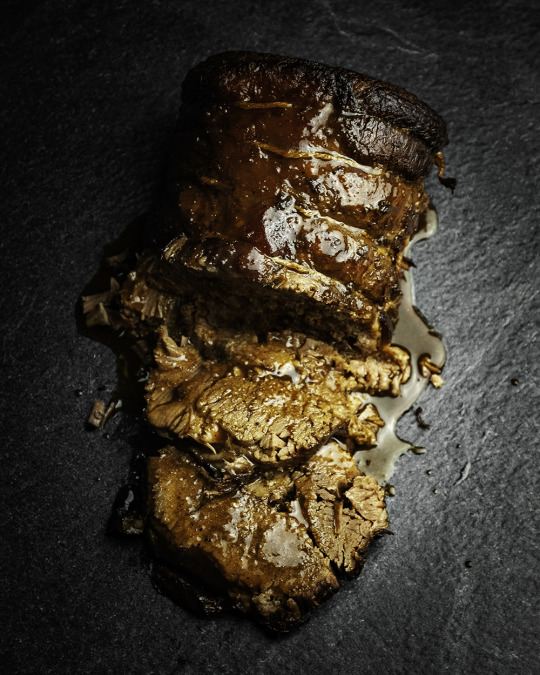
Yorkshire Brunette Beer-Braised Beef Brisket
Boned and rolled grass-fed British beef brisket from Donald Russell slow braised for four hours in Ossett Brewery Yorkshire Brunette (a traditional Yorkshire bitter brewed from pale, wheat and roasted malts) and beef stock with lightly caramelised onion and a little muscovado sugar. I made a spice rub first, massaged it into the meat, put the meat in the fridge for the spices to infuse overnight, brought the meat to room temp, browned the meat on all sides before pot-roasting in the oven at a low temperature. Fabulous aromas. Meat so soft and tender it just falls apart when you slice it. Deep, beefy, beery, umami, close your eyes deliciousness. Great as part of a dinner with Yorkshire pudding or as I did, sandwiched the meat in a crusty bread roll slathered generously with the braising liquor sieved and reduced down to a gravy consistency. Bloody lush!
Serves 4.
Ingredients:
1 x 950g Donald Russell beef brisket
rapeseed oil, for frying and browning
For the rub:
1 beef stock cube
1 tbsp ground cumin
1 tbsp smoked paprika
1 tsp cayenne pepper
1 tbsp freshly ground black pepper
2 tbsp light muscovado sugar
1 tbsp onion granules
1 tbsp garlic granules
1 tsp mustard powder
1 tbsp dried orange zest, crushed to a powder
1 tbsp dried oregano
The above ingredients makes a small batch, you only need about three tablespoons of the rub for the brisket. Save the rest for something else – roast chicken, baby back pork ribs, steak… Simply combine all the ingredients together and store in an airtight container.
For braising:
500ml Ossett Brewery Yorkshire Brunette (or a dark amber ale or bitter if unavailable)
500ml beef stock
1 brown onion, peeled and thinly sliced
1 tbsp light muscovado sugar
Method:
1. Rub the meat generously with the spice rub. Place the meat in an airtight container then refrigerate overnight.
2. Before you intend to cook the brisket, remove the meat from the fridge and bring to room temperature.
3. Preheat the oven to 150°C / 130°C fan / Gas Mark 2.
4. Heat a tablespoon of rapeseed oil over a moderate to high heat in a large frying pan. Then cook the sliced onion until lightly caramelised for about five to six minutes. Transfer the onion to a casserole pan with a lid using a slotted spoon.
5. Add a little more oil to the frying pan and brown the brisket on all sides until well caramelised.
6. Transfer the meat to the casserole pan then pour in the beer and enough beef stock to come up the side of the meat by about two thirds. Stir in the sugar.
7. Bring the pan to the boil then put the lid on and transfer to the oven and cook for four hours checking the brisket at intervals for tenderness and spoon some of the braising liquor over the top of the meat.
To serve: Remove the brisket from the pan, place on a carving board and let the meat rest for about 15 minutes. Meanwhile, pass the braising liquor through a sieve into a clean pan, spoon away as much of the fat as possible then reduce the liquor down to a gravy-like consistency to serve with the beef. So good!
3 notes
·
View notes
Photo

Scotch Whisky-Glazed Haggis Meatloaf with a Big Mac Sauce, Neeps and Tatties
A rich and sumptuous meatloaf combining haggis from Farmison, minced Scottish beef (Aberdeen Angus), minced pork and bacon - crusty on the top with a sweet whisky glaze to contrast with the tender and flavoursome savoury meat. Served with a Big Mac Sauce which complements and cuts through the richness of the meatloaf superbly. Wouldn’t be right without neeps ‘n tatties for a hearty Burns Night meal.
Serves 6.
Haggis Meatloaf
1 x 454g Farmison Traditional Haggis
500g Scottish beef, minced (e.g. Angus, Galloway, Highland)
100g lean minced pork
100g smoked bacon, finely chopped
1 large onion, finely chopped
2 large smoked garlic cloves, minced
1 large egg, lightly beaten
100g fresh breadcrumbs
a small bunch of fresh flat leaf parsley, leaves picked and finely chopped
1 tbsp fresh thyme leaves
1 tsp dried sage
1 tsp dried oregano
2 tsp Worcestershire Sauce
2 tsp Tabasco Sauce
2 tbsp Scotch whisky
unsalted butter
rapeseed oil
black pepper
1. Melt a large knob of butter and a tablespoon of rapeseed oil in a frying pan, add the finely chopped onion and cook gently with a pinch of smoked sea salt until the onion is soft and translucent but not browned. Add the minced garlic and cook for a further minute or so. Set aside and allow to cool completely.
2. Remove the haggis filling from its casing and crumble into a large bowl, then add the minced beef and pork, finely chopped bacon, herbs, egg, breadcrumbs, Worcestershire Sauce, Tabasco and Scotch whisky.
3. Add the cooled onion and mix well with your hands until well combined. Season generously with freshly ground black pepper.
4. Line the base and sides of a 1.2kg loaf tin with greaseproof baking paper, leave some of the paper hanging over the sides as this will make it easier to remove the meatloaf from the tin when it’s cooked.
5. Pack the meatloaf mixture tightly into the tin pressing it into the corners pushing out any air pockets. Using the back of a wet spoon, smooth the top of the meatloaf so it’s flat and even.
6. Put the meatloaf tin in the fridge and leave to rest for 1 hour.
While the meatloaf is chilling in the fridge, prepare the Scotch Whisky Glaze and the Big Mac Sauce:
Scotch Whisky Glaze:
100ml Scotch whisky
50g soft dark brown sugar
¼ tsp onion granules
¼ tsp garlic granules
2 tbsp Heinz Tomato Ketchup
1 tsp French’s Yellow Mustard
1 tbsp distilled white malt vinegar
½ organic beef stock cube
¼ tsp sweet smoked paprika
a pinch of ground white pepper
1. Put all the ingredients into a small saucepan the bring to the boil whisking constantly to dissolve the sugar.
2. Reduce the heat and simmer until reduced to a glaze consistency, about five minutes until all the sugar has dissolved. Set aside until ready to use.
Big Mac Sauce:
300g mayonnaise
1.5 tbsp sweet pickle relish
2 tbsp pickled gherkin, finely chopped
1 tsp Heinz Tomato Ketchup
1 tsp French’s Classic Yellow Mustard
2 tsp crispy dried onion, crushed to a powder
2 tsp distilled white vinegar
½ tsp sweet smoked paprika
a pinch of ground white pepper
a pinch of sea salt
Put all ingredients into a saucepan, simmer gently for a few minutes. Cool, then blitz in a blender. Transfer to small bowl, cover with cling film and refrigerate until ready to use.
To cook the meatloaf:
1. Remove the meatloaf from the fridge and preheat the oven to 170°C/150°C fan/gas 3½. Place the meatloaf tin on a baking tray and bake for 1 hour and 30 minutes.
2. Remove the meatloaf tin from the oven and brush the top of the meatloaf generously with the glaze.
Neeps and Tatties
1kg potatoes washed, unpeeled and cut into large chunks
650g swede peeled and cut into large chunks
25g butter
rapeseed oil
sea salt
black pepper
1. Preheat the oven to 220°C/200°C fan/gas 7.
2. Put the potatoes into a pan of lightly salted boiling water. Bring the pan back to the boil and simmer for 5 minutes then drain in a colander. Let the potatoes steam for a few minutes.
3. Pour a thin layer of oil into a large roasting tray and place in the preheated oven. When the oil is smoking hot remove the tray from the oven then add the potatoes. Toss the potatoes to coat them in the oil then scatter with sea salt and freshly ground black pepper. Place in the oven to roast for 30 minutes, turning occasionally.
4. Meanwhile, cook the swede in salted boiling water for about 25 minutes or until soft when pierced with a sharp knife. Drain the swede in a colander, let steam for five minutes, then add to the roasted potatoes. Toss everything around in the tray coating the swede in oil. Lightly crush the vegetables but keeping them fairly chunky and whole. Return to the oven and roast for a further 15 minutes.
5. Remove the tray from the oven, toss the vegetables around again, crushing them again if necessary. Place knobs of butter on top of the vegetables, scatter with thyme leaves then return to the oven for a final 15 minutes and cook until crisp.
0 notes
Photo
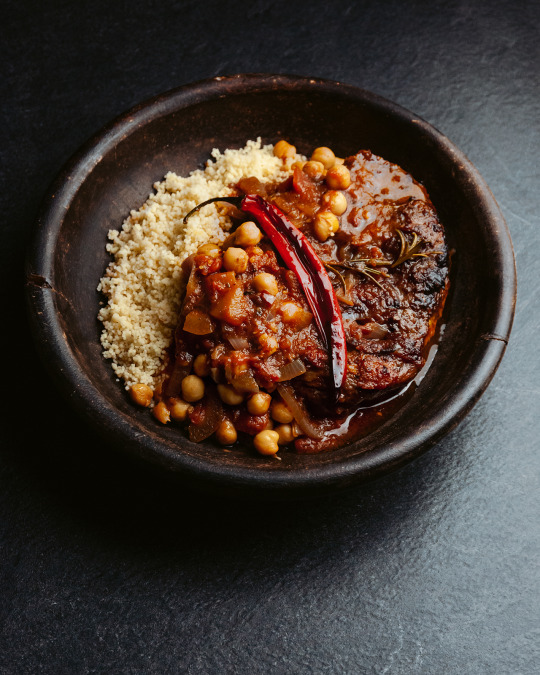
HARISSA-BAKED HERITAGE LAMB STEAK WITH CHICKPEAS
Fiery flavours. Beautifully tender and flavoursome 7-Day Dry-Aged Suffolk Lamb Leg Steaks from Farmison pan-seared then slow-baked in the oven with tinned tomatoes, red onion, garlic, harissa, chillies, rosemary, lamb stock and chickpeas. Really satisfying and plenty of heat, how I like it. Bags of flavour so serve simply with steamed couscous.
Ingredients:
4 Farmison 7-Day Dry-Aged Suffolk Lamb Leg Steaks (approx. 250g each)
2 large red onions, finely sliced
4 large smoked garlic cloves, minced
4 rosemary sprigs, leaves picked
2 x 400g tins chopped tomatoes
2 x 400g tins chickpeas, drained
4 large red chillies, cut a small slit in them but keep them whole
2 tbsp harissa paste
extra virgin olive oil
2 tbsp plain flour
1 tsp dried rosemary
1 tsp dried oregano
Maldon smoked sea salt
freshly ground black pepper
Method:
1. Pre-heat the oven to 170°C/150°C fan/Gas 3½.
2. In a small bowl, mix the flour with the dried rosemary and oregano and some smoked sea salt and freshly ground black pepper.
3. Pat dry the lamb with kitchen paper and allow to come to room temperature then dust with the flour mixture.
4. Heat two tablespoons of extra virgin olive oil in a large deep-sided frying pan over a moderate heat then brown the lamb on all sides until well caramelised – about 2 to 3 minutes on each side. Remove the lamb steaks from the pan then set aside.
5. Add the red onion to the pan and cook until soft for a couple of minutes. Add a little extra virgin olive oil to the pan if necessary.
6. Add the minced garlic and briefly cook until you can smell the garlic, don’t let it burn. Add the chillies then pour the tinned tomatoes into the pan and stir everything together.
7. Pour the lamb stock into the remains of what’s left in the tomato tins and swirl around then pour into the pan. Stir in the harissa paste and drained chickpeas followed by the rosemary.
8. Pour everything into a large roasting tray or ovenproof dish then add the lamb tucking it in so it’s mostly covered.
9. Cook uncovered in the oven for 45 to 50 minutes.
1 note
·
View note
Text
Red Deer Osso Buco
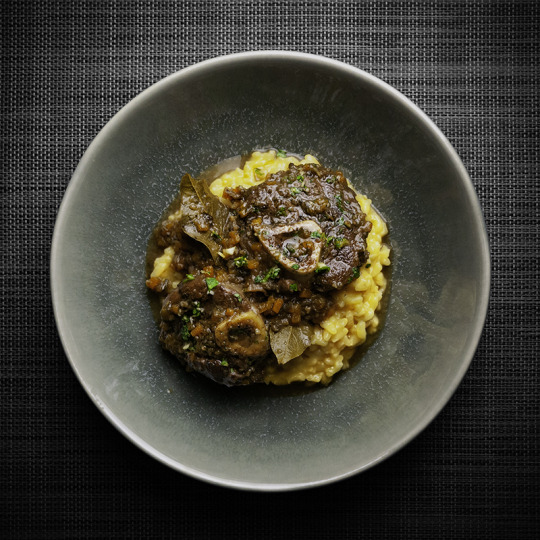
I first tried ‘Osso Buco in Bianco’ in Milan about ten years ago and it was served with ‘Risotto Milanese’. It tasted excellent, a memorable dinner. This is my take on the classic Italian dish but with red deer on the bone, instead of veal. I seasoned the meat with smoked sea salt and crushed juniper berries to enhance the wild gamey flavour then cooked it in white wine and game stock with herbs and finely chopped vegetables for about two hours until meltingly soft and almost falling off the bone. The meat, from Donald Russell, comes from wild Scottish red deer, cut from the meaty hind quarter shin containing the buttery marrowbone. The flavour is quite dark with distinctively wild aromas but balanced by a silky saffron risotto with plenty of Parmesan. Serve with a gremolata of finely chopped garlic and flat-leaf parsley and grated lemon zest to finish. Delicious!
Serves 4.
Ingredients:
1.2 kg Donald Russell Red Deer Osso Buco
1 carrot, very finely diced
1 celery stick, very finely chopped
1 brown onion, finely chopped
1 rosemary sprig, leaves picked and finely chopped
4 sage leaves
4 bay leaves
2 strips of lemon zest, white pith removed
200ml dry white wine
1 litre game (or beef) stock
plain flour, for dusting
olive oil
Maldon smoked sea salt
freshly ground black pepper
6 crushed juniper berries
Method:
1. Pat dry the osso buco with kitchen paper, dust with flour and season with sea salt, black pepper and crushed juniper.
2. Heat a good glug of olive oil in a large casserole pan with a lid and brown the osso buco on all sides then transfer the meat to a warm plate.
3. In the same pan; add the carrot, celery and onion and fry over a medium heat until soft but not browned for about 8 minutes.
4. Pour in the wine and cook until it has reduced by a third.
5. Return the meat to the pan then add the beef stock, herbs and lemon zest.
6. Bring the pan to a simmer and cook gently, with the lad on the pan slightly ajar to release steam, for about two hours until the meat is tender.
7. Check the pan from time to time and keep skimming to remove froth and fat that floats to the surface for a finer end result.
Saffron Risotto
Ingredients:
1.5 litres chicken stock
100g unsalted butter
4 tbsp olive oil
1 large echalion shallot, very finely chopped
125ml dry white wine
300g carnaroli risotto rice
1g saffron threads
50g Parmesan, freshly grated
Maldon sea salt
freshly ground black pepper
Method:
1. Put the stock in a saucepan and keep warm over a low heat.
2. Melt half of the butter with olive oil in large high-sided non-stick frying pan. Then add the chopped shallot along with a pinch of sea salt. Cook until soft but not browned for about 7 minutes.
3. Add the rice and stir to coat the rice in the butter and oil.
4. Pour in the wine and stir until all the wine has been absorbed by the rice.
5. Add a ladle of the chicken stock and stir again. Wait until the rice has absorbed all of the stock before adding the next ladle, avoid drowning the rice.
6. Add the saffron threads after 10 minutes cooking time.
7. Repeat adding the stock until all of it has been absorbed by the rice. This will take approximately 25 to 30 minutes in total – the rice should be yellow, soft and creamy but still retaining some bite.
8. Stir in the rest of the butter, the Parmesan and season with sea salt and freshly ground black pepper to taste.
Gremolata
2 garlic cloves, very finely chopped
2 tsp finely grated lemon zest
2 large handfuls of flat-leaf parsley, finely chopped
Christmas will soon be here, so if you're looking for something different to cook during the festive season, then this would make a nice addition to your menu...
If you fancy cooking this particular cut well, Donald Russell, currently have an offer on where you can get 20% off plus free delivery to your door up until 20th December when you spend £50 and use this code: YORK19.
2 notes
·
View notes
Text
A Dacia Road Story

Above: Dacia Duster (Prestige Blue dCi 115 4x2)
Having been offered a Duster by Dacia UK to head out on a road trip for a week, I grasped the opportunity to drive up to Scotland, in particular the Isle of Skye, a place I’d wanted to visit for years. Clocking up a total of 1,469 miles, this was a trip I will always remember.
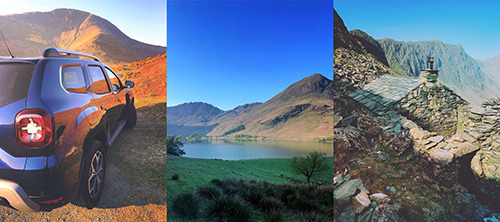
Above: Buttermere and Warnscale Head Bothy
Boot packed and heading out from home in Wakefield, West Yorkshire, my first stop was the Lake District, a hike to Warnscale Head Bothy from Gatesgarth. The route to Gatesgarth via Keswick, at the north of the Lakes, took in some challenging twisty single-track roads; up and down like a rollercoaster, scenic views along the way, roaming sheep providing the occasional obstacle. The drive was a joy, the Duster proved nimble yet powerful and the commanding seat height offered great visibility taking in Honister Pass with its narrow bends and steep gradients (1 in 4 in some places) with ease. I arrived at Gatesgarth early greeted by golden morning light and blue skies. Stepping out of the car – silence and serenity, quiet birdsong, dappled light and the rush of water in a nearby stream. It was Easter Monday and contrary to previous Easter bank holidays the temperature was already soaring, just like the mountains in the haze. Laden down with weight, my rucksack was hefty, a quarter of it filled with logs and kindling to fuel the wood burning stove at the bothy in order to cook lunch; pan-seared rump of Herdwick lamb with a wild garlic salsa verde and crispy new potatoes with lemon and thyme. Cooking in the bothy felt like going back in time, so primitive with just a few pans over the heat of the wood burner, and highly satisfying, easily one of my best bothy meals in what’s become known as ‘a room with a view’ looking down over Buttermere.
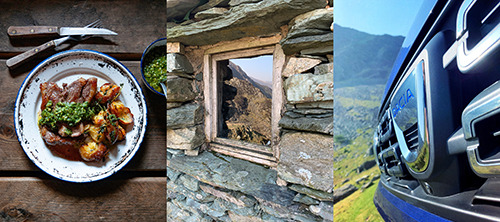
Above: Herdwick Lamb, Warnscale Head Bothy - ‘a room with a view’, Duster
After an overnight stay in the Lakes I embarked for Scotland feeling the sense of anticipation of what was to come: The Isle of Skye, a place I’d wanted to visit for years, and now, I was on the road, on my way. The drive was a long but scenic one offering jaw-dropping views – Ben Nevis, Loch Lomond, Rannoch Moor, The Buachaille and the Pap of Glen Coe, each area bringing back memories as if it was yesterday that I was there hiking with my family. The Lake District is beautiful and majestic but Scotland with its vastness is something else. At long last, Skye was in sight! I pulled over into a layby next to Loch Alsh, Skye Bridge in the distance. I paused for few moments by the Loch taking in the view before the final approach. The scenery was breath taking, layers of mountains in the haze. I still had a fair drive to my destination, Shulista, at the far north of Skye. It was early evening by the time of my arrival at Shulista Croft Wigwams, my home for the next two nights. I was greeted by a warm welcome. I didn’t even bother to unpack, the evening was blessed with a sunset, so after being on the road for ten hours I then embarked on foot, on a few miles hike up to Rubha Hunish, the most northerly point on Skye to take in the sunset by the sea. I returned in darkness via an indistinct path which started to get a bit eerie. I was glad to reach my home for the night. It was a breezy but clear night, warm and cosy in the wigwam and the sound of the wind outside quickly sent me to sleep.

Above: The Buachaille, Rubha Hunish, Shulista Croft Wigwams
The following day was spent sourcing ingredients; bread from from the Isle of Skye Baking Company in Portree and Alderwood Smoked Salmon from the Isle of Skye Smokehouse in Ard Dorch. A beautiful drive along the cliff tops at the west of the island, blue skies, warm sunshine and breezy. The following day I cooked breakfast at The Lookout Bothy at Rubha Hunish – scrambled eggs from Shulista Croft (incredible eggs Maran and Sussex White with such yellow yolks and I got a double yolker!) served with the smoked salmon and toasted corn bread from Skye Bakery. And what a place to sit and eat breakfast!

Above: West of Skye above Uig, Breakfast at The Lookout Bothy
The next few days were spent exploring the island by car and on foot. Skye is a bigger island than you realise, I clocked up a fair few miles just driving around. A week on Skye and I felt I’d only really scratched the surface – a wander at the base of the Cuillins which looked like the French Alps in the sunshine set against a pure blue sky, a hike up The Old Man of Storr, the Quiraing, Neist Point Lighthouse and a five-mile drive via a dirt track into wild and remote terrain, 400m above sea level, at the south of Skye not far from the summit of Beinn Dubh a’ Bhealaich where I cooked Stovies, a traditional highland stew of Aberdeen Angus and Highland beef with potatoes mopped up with some crusty bread.

Above: One Man and a Dacia, The Old Man of Storr, The Quiraing
All in all, it was a truly epic week. Many memories made and I met some of the friendliest folk along the way. Thanks to John Corfield for allowing me to visit his smokehouse which is based on a traditional Scottish cleit and the smoked salmon was incredible! Thanks to Adam and Sally Williams at Shulista Croft Wigwams, such a friendly couple, I enjoyed our chats and thank you for the eggs! Loved watching all the lambs. I hope to return one day! Manythanks to Dacia UK for facilitating this trip to Skye in the first place,enabling me to reach the places I’d dreamed of. I enjoyed every minute and every mile driving the Duster. If you’re feeling inspired, why not start planning your Dacia road trip and book a test drive with a Duster today at: www.dacia.co.uk.
This trip was a paid collaboration with Dacia UK, who gifted me a Duster for a week. Check out more highlights from my trip on their Instagram channel: www.instagram.com/dacia_uk/.
1 note
·
View note
Text
Wild Garlic Kimchi
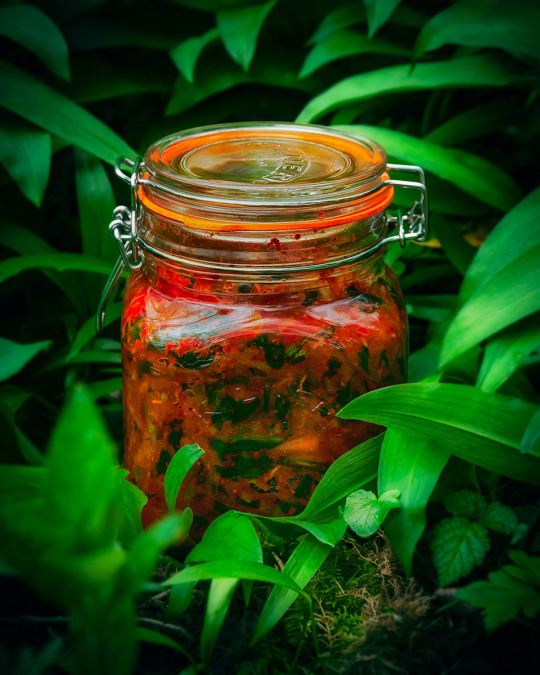
This tastes great even before fermentation and it’s a great way of prolonging the flavour of these wild spring leaves beyond the season. It’s really easy to make: Collect about 500g wild garlic leaves, stems and flower buds then mix with kimchi paste. I used Gochugaru (Korean chilli powder) with grated daikon, shredded leek, root ginger, fish sauce, sea salt and sugar. Pack the mixture into a jar, leave at room temperature for 24 hours for the lacto-bacteria to do its work, then refrigerate for a week. I’m planning on serving this with something with a Korean vibe; Bulgogi-marinated short rib of beef, oak-smoked, slow-cooked until tender then caramelised over a griddle or wood fire. Here’s my recipe:
Ingredients:
500g wild garlic leaves, stems (and flower buds if available)
For the kimchi paste:
50g gochugaru (Korean chilli powder)
250g daikon, peeled and grated
125g leek, finely sliced
3 tbsp root ginger, peeled and finely grated
1 tbsp fish sauce
2 tbsp sea salt
3 tbsp granulated sugar
Method:
Mix all the kimchi paste ingredients together in a bowl. Rinse the wild garlic leaves and stems then spin dry. In a large bowl mix the wild garlic with the paste, be quite thorough and use your hands to squeeze the wild garlic until there is enough liquid in the bowl.
Put the mixture in a clean clip-top jar, press the mixture down to eradicate any air pockets. Try to fill the jar as much as possible therefore leaving less oxygen in the jar. Leave the jar to stand for 24 hours, this starts the fermentation process by allowing lacto-bacteria to breed at room temperature. After 24 hours put the jar in the fridge. The kimchi is ready to eat in a week and will keep for a few weeks, possibly a month or longer, in the fridge. Don’t open the jar until the kimchi is ready to use.
8 notes
·
View notes
Quote
Only those who will risk going too far can possibly find out how far they can go.
Alexander Supertramp (Christopher McCandless) - 12 Feb 1968 - 18 Aug 1992
0 notes
Text
Yorkshire Provenance and French Terroir
There’s a strong sense of pride, heritage and provenance here in Yorkshire. Provenance matters and can mean many different things to us be it ethics, environmental concerns or traceability. But what about ‘terroir’?
During my visit to Montpellier and the Occitania region of France last December, I felt a strong sense of provenance particularly in the markets. It was apparent that there was an underlying awareness and knowledge of where a particular ingredient came from be it the meat, vegetables, cheese or wine, everything is traceable. And in the restaurants strong evidence of locally sourcing therefore cutting down on the food miles and championing the produce of the regions. At the restaurant ‘Contrat’, for example, in Montpellier, I was served veal sausage from Rieupeyroux in Aveyron plated with Laguiole, a cow’s milk cheese from the plateau of Aubrac also in Aveyron with a well matched dry white wine – Mas d’Agalis – Le Grand Carré 2016 from Languedoc-Roussillon. The French have an understanding of the characteristics of each ingredient, where it comes from and how to combine them and certainly how to match those wines to enhance the food in an almost symbiotic way. Beyond provenance is ‘terroir’ which translates literally to the land – the earth or soil – the habitat. French wine production is an obvious example where terroir has a significant part to play in the resulting characteristics of the wine dependent on the vines, the soil, climate, cultivation and even lunar cycles.

All food in France it seems is affected and governed by terroir and ultimately this affects the resulting flavour. Lamb, for example, from Aveyron, located in the north of the Occitanie region in southern France, has a grassy and herbaceous flavour indicative of the terroir, i.e. the pastures where the sheep graze. We don’t have the warm climate that the south of France has here in the UK in which to produce great red wine, but Leventhorpe Vineyard located in Woodlesford, Leeds produce some excellent whites. The way in which cheese is produced in France is also indicative of the region where it comes from, like Salers, a semi-hard cow’s milk cheese produced in the mountains of Auvergne in central France. Salers are a breed of cattle which originated in Cantal in the Massif Central of France. Salers has a wonderful bittersweet flavour starting out slightly bitter then ending with a sweet and tangy finish that lingers on the tongue. I also tried La Marotte at Le Marché des Arceaux in Montpellier, La Marotte is a tomme style ewe’s milk cheese from the Larzac matured for up to 12 months in natural caves. The flavour is medium/strong, nutty and earthy.
Elsewhere in Yorkshire, there are companies like Farmison, an online retailer based in Ripon who champion the heritage breeds of the British Isles sourcing directly from the farms, they even give tasting notes of the meat they sell. And there are now over 750 different cheeses produced in Britain overtaking France. As a Yorkshireman I may be biased in singing the praises of my home county, but the 24-month aged Comté I tasted at Les Halles Laissac in Montpellier was on another level. I had to bring some home with me. The French are renowned for their gastronomy and rightly so, but we have a lot to be thankful for here in the UK too, let us go beyond provenance and fully embrace our own terroir, adopt more of the French attitude and sophistication towards food and appreciation of where it comes from. Plan a trip to Montpellier and experience the same sense of enlightenment that I had. Take a day trip exploring the wine, the terroir, the gastronomy and everything in between with Bertrand Bosc who took me on a tour of the Pic-Saint-Loup and a visit to Château La Roque, a historic wine estate about 12 miles north of Montpellier. Bon Appétit!

1 note
·
View note
Text
Lentil and Mushroom Cottage Pie
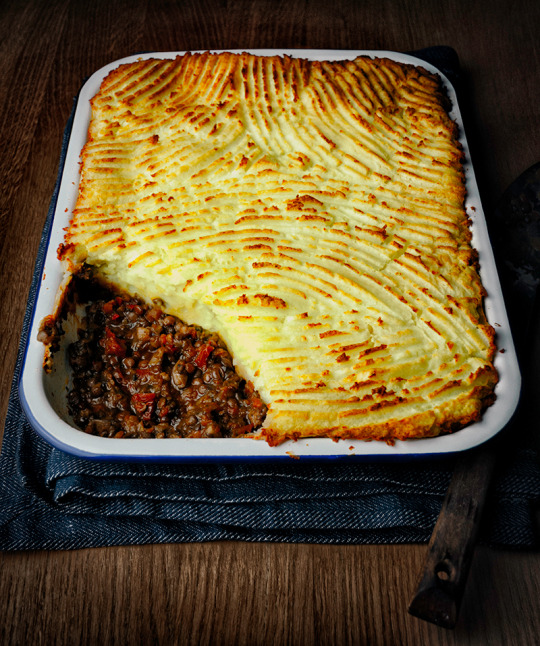
I was craving a cottage pie after a winter walk in the Peak District, cold weather often makes me crave comfort food. My pie filling here is rich and savoury and completely vegan; portabella and chestnut mushrooms, lentils, sun-dried tomatoes, caramelised leek and shallots, garlic, carrots, organic vegetable stock, loads of herbs and a bit of Vegemite for a good savoury hit topped with olive oil mashed Maris Piper potatoes. Bags of flavour and just as tasty as a good meat-based cottage pie where the flavour is really dependent on the quality of the meat. My daughter is now vegan, so I wanted to cook a family meal that was a compromise – vegan but meaty in flavour! I’m glad to say we all really enjoyed this. Here’s the recipe.
Serves 6.
Ingredients:
300g lentils
250g portabella mushrooms, finely chopped
250g chestnut mushrooms, finely chopped
2 large carrots, peeled and finely chopped
3 cloves garlic, crushed
1 leek, finely chopped
4 shallots, finely chopped
1 red chilli, de-seeded and finely chopped
8 sun-dried tomatoes, roughly chopped
1.5 litres hot organic vegetable stock
1 handful of flat leaf parsley, finely chopped
2 sprigs of sage, finely chopped
3 sprigs of thyme, leaves picked and finely chopped
2 sprigs of rosemary, leaves picked and finely chopped
2 bay leaves
3 tsp Vegemite
2 tsp tomato purée
2kg maris piper potatoes, boiled and mashed
olive oil
sea salt
ground white pepper
granulated sugar
Equipment required:
large casserole type pan
30cm x 20cm baking dish
Method:
1. In a large casserole type pan with a lid, caramelise the chopped leek and shallots in olive oil over a medium heat. Then add the garlic, carrots and red chilli. Put the lid on the pan to sweat the vegetables until soft, about 8 minutes.
2. Stir in the chopped sun-dried tomatoes and all the herbs.
3. In a large frying pan, sauté the chopped mushrooms in olive oil over a medium to high heat until well browned. The mushrooms will give release water as they cook, when all the liquid has evaporated transfer the mushrooms to the casserole pan using a slotted spoon, then stir everything together.
3. Next add the lentils, tomato purée and Vegemite to the pan. Stir everything together to coat the lentils with all the flavours.
4. Add the vegetable stock and bring to the boil. Reduce the heat and simmer gently uncovered for about an hour. If the mixture begins to evaporate too quickly add a little freshly boiled water.
5. Meanwhile, boil and mash the potatoes. Stir in a drizzle of olive oil and season well with sea salt and a little ground white pepper. Set aside until you’re ready to assemble the pie.
6. After an hour, the pie filling should have thickened and taste rich and savoury. Check the flavour and season to taste with sea salt and balance with a sprinkle of granulated sugar to sweeten if necessary, about a teaspoon or so.
7. Pre-heat the oven to 180°C/160°C (fan oven).
8. Remove the bay leaves and pour the pie filling into the baking dish and top with mash. Use a fork to carve lines into the mash for a crispy finish.
9. Bake the cottage pie for about 30 minutes until the mash looks golden and has a nice crust. Serve piping hot with some simply cooked greens such as garden peas or broccoli.
7 notes
·
View notes